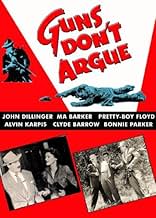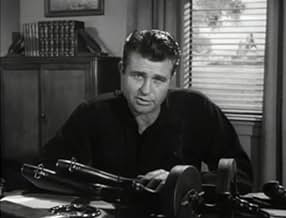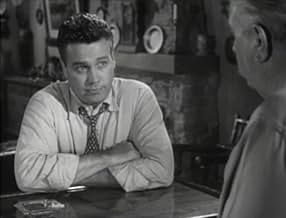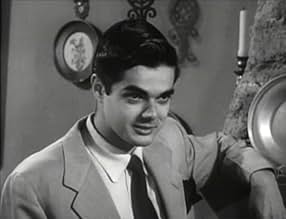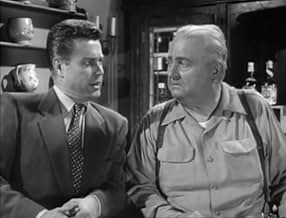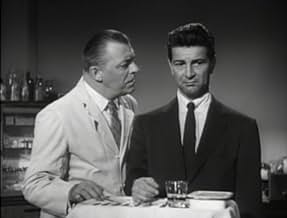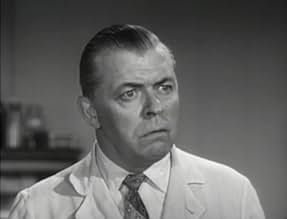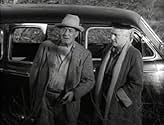Añade un argumento en tu idiomaA composite of three re-edited episodes from the 1952 TV series, Gangbusters, released to theatres in 1957 as a feature film. Gang Busters (1954) was a similar effort.A composite of three re-edited episodes from the 1952 TV series, Gangbusters, released to theatres in 1957 as a feature film. Gang Busters (1954) was a similar effort.A composite of three re-edited episodes from the 1952 TV series, Gangbusters, released to theatres in 1957 as a feature film. Gang Busters (1954) was a similar effort.
- Dirección
- Guión
- Reparto principal
Baynes Barron
- Clyde Barrow
- (as Baynes Baron)
Lash La Rue
- 'Doc' Barker
- (as Lash Larue)
Reseñas destacadas
This feature-length movie has been edited from episodes of the 1952 TV series, Gangbusters. The style is government informative shorts presented by police agents and promoting their exploits. It dramatizes various gang crews and their ultimate downfalls. Some of the famous names include Pretty-Boy Floyd, Bonnie and Clyde, John Dillinger, and Ma Barker.
In a way, this is an interesting look into early television. As a movie, it is little vignettes that don't gel together. Sure, I remember the shootout with the Barkers. Maybe the final Bonnie and Clyde shootout helps informed the later movie. Far more often, this is a weak production of disjointed scenes and I don't know the vast majority of these actors. The constant changing of the characters do not help.
In a way, this is an interesting look into early television. As a movie, it is little vignettes that don't gel together. Sure, I remember the shootout with the Barkers. Maybe the final Bonnie and Clyde shootout helps informed the later movie. Far more often, this is a weak production of disjointed scenes and I don't know the vast majority of these actors. The constant changing of the characters do not help.
The history of early-twentieth-century organized crime, and the response of law enforcement, narrated on the budget of a high-school sex-ed movie. Martin Scorsese recommended this movie as the ultimate exemplar of visual storytelling on a well-worn shoestring, and he knows whereof he speaks: even Sam Fuller never had to portray a shooting death by dissolving to stock footage of a firing gun.
It was, just as it says at the top of the page, several episodes of the syndicated TV series, GANGBUSTERS, stitched together to make a feature-length film for the drive-in and grind-show theatres, and the producers were only interested in getting some more return on their investment...and didn't much care if some theatre patron came away miffed because he had already seen this mess for free on television, scattered across several 30-minute episodes. Each of those told a single story of some gangster or gangs, through some law-enforcement agent, and sometimes had different narrators telling the story.
Based on Philip H. Lord's radio program, and the comic strip of the same name. This is not one of the FBI-endorsed films or, to be exact, television series.
Based on Philip H. Lord's radio program, and the comic strip of the same name. This is not one of the FBI-endorsed films or, to be exact, television series.
So how did this teenage drive-in freak miss a title like this back in '57. Just lucky, I guess. However you look at the 90-minutes, the result is a mess. It's a composite made up of episodes from a 1952 TV series "Gangbusters", while the editing shows more fascination with tommy-guns than anything else. It doesn't matter who the real life desperado is- Dillinger, Karpis, Pretty Boy Floyd- it's the tommy guns that do the talking. Then too, I love the way the Hollywood splatter seldom hits its mark. That way, we get extended bursts. Since there's no plot, just a collection of shoot-outs, don't expect a story. One notable exception is Jean Harvey as the formidable Ma Barker. Her fiery demeanor is scarier than any of the male desperadoes. Looks like her talents could fit into an A-production in an otherwise brief career.
True to its "Dragnet" time period, the aim (if you can call it that) is to laud law enforcement ( here, the FBI) as they gun down a succession of Public Enemy #1's. Also true to the period, the gang molls sport twin peaks and tight skirts- so guys, there are two paramount compensations. Nonetheless, it's a movie unlike any I've seen, or ever want to see.
True to its "Dragnet" time period, the aim (if you can call it that) is to laud law enforcement ( here, the FBI) as they gun down a succession of Public Enemy #1's. Also true to the period, the gang molls sport twin peaks and tight skirts- so guys, there are two paramount compensations. Nonetheless, it's a movie unlike any I've seen, or ever want to see.
Apparently re-cut episodes from the Gangbusters TV show on the big screen. While this was frequently done in the 50's and 60's because people didn't have a TV or a color TV and producers wanted an increased return on their investment (big screen ticket sales or if it went to the small screen resale of a series that isn't in syndication), the results were usually less then the sum of their parts. The only time I've ever seen it work were where multi-part stories were put together (Ala Rocky Jones or Man From Uncle) or in the case of horror anthology (The Veil and 13 Demon Street). Here the effect is to have stories of American criminals in the 20's and 30's (Dillinger, Pretty Boy Floyd, Bonnie and Clyde, etc)inter-cut with each other as a narrator talks about how the FBI hunted them down. Its a weird concoction that doesn't quite work because its clear that there are things here that don't belong together. More than once I looked at the TV oddly because things didn't seem right. In fairness I won't describe the cheapness of the production since this was what early TV (and the series) was like. Its not bad, but its not very good either. To be perfectly honest the episodes of the series that I've seen work better a single episodes where we're not expecting as much. Given the choice I'd rent dvds of the show instead of this movie.
¿Sabías que...?
- CuriosidadesAs usual for bottom of the barrel 1950's re-enactments, clothing. furniture, and even automobiles are strictly late 1940s/early 1950s vintage, not 1920s and 1930s especially in the Kansas City Massacre, although the names of notorious gangsters killed in the 1930s, such as Clyde Barrow, Bonnie Parker and Pretty Boy Floyd are tossed around like confetti.
- PifiasThough set in the 1930s, the film's sets, costumes and many of the cars seen in it are all from the 1950s.
- ConexionesEdited from Gang Busters (1952)
Selecciones populares
Inicia sesión para calificar y añadir a tu lista para recibir recomendaciones personalizadas
Detalles
- Fecha de lanzamiento
- País de origen
- Idioma
- Títulos en diferentes países
- Guns Don't Argue!
- Localizaciones del rodaje
- Pacific Ave & Windward Ave, Venice, Los Ángeles, California, Estados Unidos(as Beverly Dr & 38th St, Sioux Falls)
- Empresa productora
- Ver más compañías en los créditos en IMDbPro
- Duración
- 1h 32min(92 min)
- Color
- Mezcla de sonido
- Relación de aspecto
- 1.37 : 1
Contribuir a esta página
Sugerir un cambio o añadir el contenido que falta

